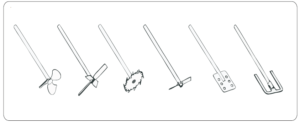
The chemical instrument industry has experienced rapid growth in recent years, particularly in fields such as pharmaceuticals, chemicals, food processing, and biotechnology. With advancements in technology and the growing diversity of market demands, the chemical instrument market continues to expand, exhibiting several key trends. This article delves into these trends, offering an in-depth analysis of future opportunities and challenges for businesses in the sector.
1. Smart and Automated Technologies: Enhancing Laboratory Efficiency
Smart and automated technologies have emerged as major driving forces in the chemical instrument market. Laboratories are increasingly demanding high-precision and automated operations, pushing more laboratory equipment to adopt advanced automation controls and data processing technologies. For example, modern chemical analysis instruments not only generate experimental data quickly but also process results autonomously, significantly improving laboratory efficiency.
The integration of Internet of Things (IoT) technologies has further revolutionized chemical instruments, enabling remote control and real-time data transmission. This allows laboratory personnel to monitor experiments in real time and make swift adjustments, reducing human intervention and minimizing errors. In areas such as high-throughput screening and quality control, automated instruments have become crucial for improving productivity and data accuracy.
2. Green and Sustainable Development: Driving Demand for Low-Energy Equipment
Growing global concerns about environmental sustainability have driven the chemical instrument industry towards more eco-friendly and sustainable practices. Green chemical instruments aim to reduce energy consumption and waste production while ensuring safety and efficiency in experiments. Laboratories are increasingly opting for low-energy, high-efficiency instruments to comply with stringent environmental regulations.
For instance, low-temperature cooling devices and energy-saving heating equipment are widely used in experiments requiring temperature control, as they help reduce energy consumption. Instrument manufacturers are also focusing on developing sustainable materials and reducing the use of chemical solvents, making instrument design more environmentally friendly. This green trend not only aligns with environmental objectives but also helps laboratories lower operational costs.
3. Growth Opportunities in Emerging Markets: The Rise of the Asia-Pacific Region
The Asia-Pacific region, particularly China and India, is becoming a key growth driver in the global chemical instrument market. As industrialization accelerates in these regions, demand for chemical analysis, quality control, and laboratory testing equipment is increasing significantly. Market research indicates that the Asia-Pacific region will lead the expansion of the chemical instrument market in the coming years.
This rapid development in emerging markets presents abundant opportunities for chemical instrument manufacturers. Companies can capitalize on these markets by optimizing their supply chains, offering localized services, and developing flexible market strategies. For example, many companies are creating portable, cost-effective chemical instruments to meet the demands of emerging markets for compact, low-cost equipment.
4. Continued Investment in R&D: Innovation Drives Competitive Advantage
To maintain a competitive edge in this increasingly competitive market, chemical instrument companies are investing heavily in research and development (R&D). Innovation is not only reflected in instrument performance but also in user-friendly interfaces and software integration capabilities. Many laboratory analysis instruments now feature intelligent interfaces, cloud-based data analysis, and programmable functions, offering users greater flexibility and convenience.
Additionally, companies are focusing on developing equipment that complies with global industry standards and regulations, ensuring that their instruments meet strict compliance requirements. This helps manufacturers expand their market reach and strengthens their competitiveness in international markets.
5. Digital Sales and Online Services: Growth of E-Commerce Platforms
With the rise of e-commerce and digital transformation, more chemical instrument manufacturers are selling their products through online platforms. B2B e-commerce websites provide businesses with convenient purchasing options, while virtual demonstrations and online support tools enhance the customer experience. Digital sales not only reduce operational costs but also significantly improve customer satisfaction.
By optimizing digital sales channels, chemical instrument companies can quickly reach global markets, providing flexible after-sales services and technical support. As online purchasing becomes the mainstream for laboratory equipment, digital transformation opens up greater market opportunities for businesses.
Conclusion
The future of the chemical instrument market is full of opportunities. The trends of smart automation, green sustainability, and the rapid development of emerging markets present significant growth potential for manufacturers and suppliers. By staying aligned with these industry trends, fostering technological innovation, and expanding digital sales channels, chemical instrument companies can maintain their competitive edge in a rapidly evolving market.
For businesses that can quickly adapt to changing market conditions and meet customer needs through innovation, the future holds limitless possibilities.

